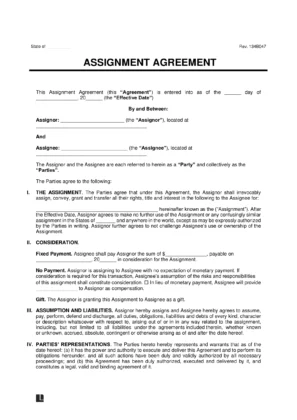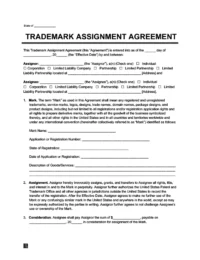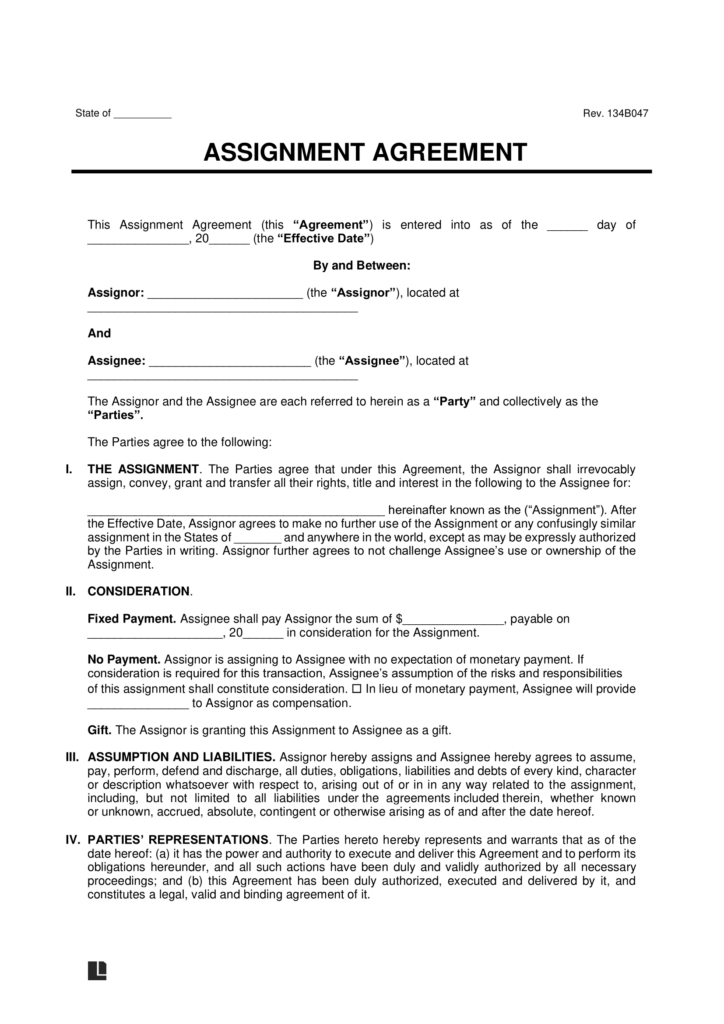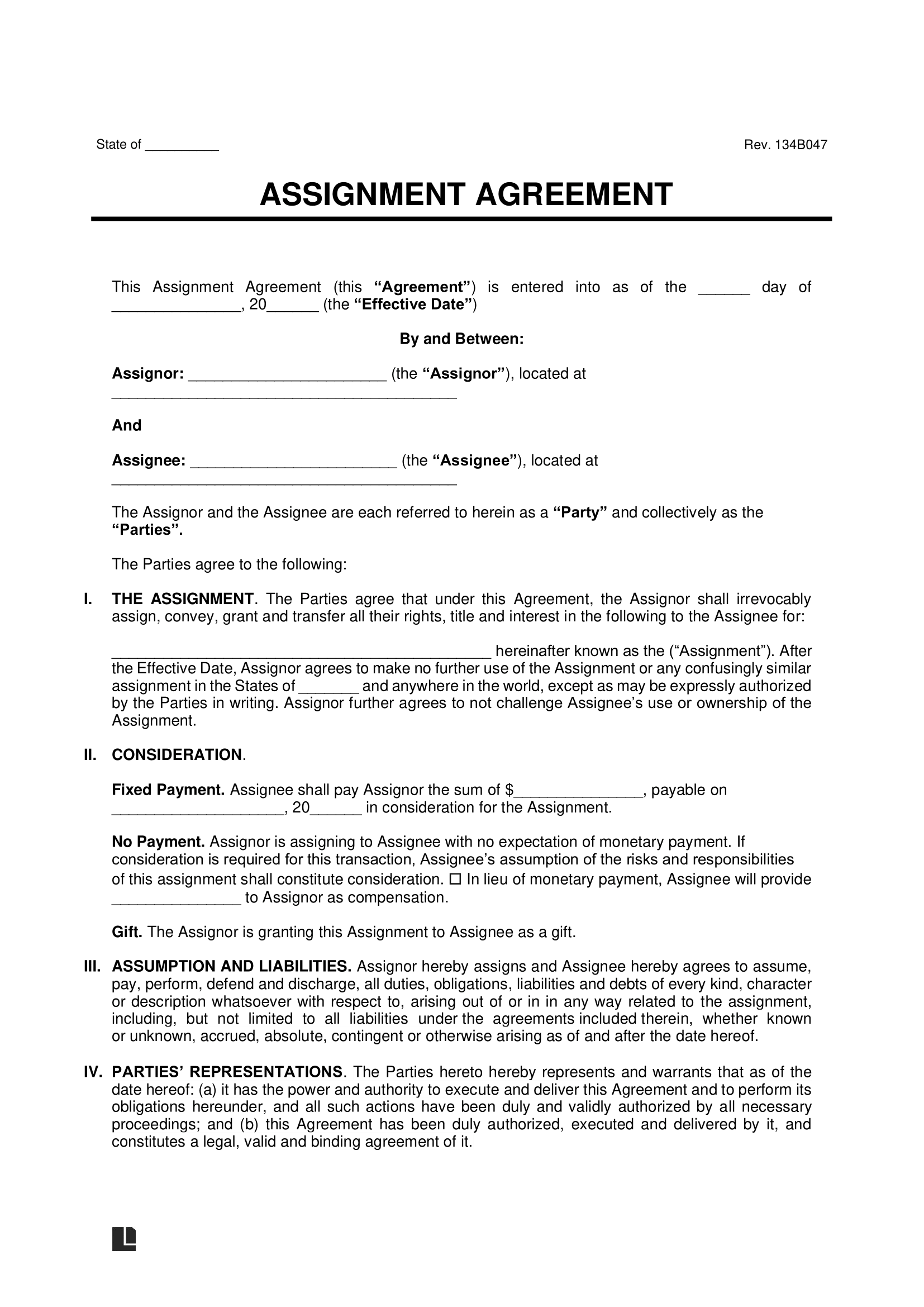- Skip to primary navigation
- Skip to main content
- Skip to primary sidebar
- Skip to footer
Legal Templates
Home Assignment Agreement

Assignment Agreement Template
Use our assignment agreement to transfer contractual obligations.

Updated February 1, 2024 Written by Josh Sainsbury | Reviewed by Brooke Davis
An assignment agreement is a legal document that transfers rights, responsibilities, and benefits from one party (the “assignor”) to another (the “assignee”). You can use it to reassign debt, real estate, intellectual property, leases, insurance policies, and government contracts.
What Is an Assignment Agreement?
What to include in an assignment agreement, how to assign a contract, how to write an assignment agreement, assignment agreement sample.

Partnership Interest
An assignment agreement effectively transfers the rights and obligations of a person or entity under an initial contract to another. The original party is the assignor, and the assignee takes on the contract’s duties and benefits.
It’s often a requirement to let the other party in the original deal know the contract is being transferred. It’s essential to create this form thoughtfully, as a poorly written assignment agreement may leave the assignor obligated to certain aspects of the deal.
The most common use of an assignment agreement occurs when the assignor no longer can or wants to continue with a contract. Instead of leaving the initial party or breaking the agreement, the assignor can transfer the contract to another individual or entity.
For example, imagine a small residential trash collection service plans to close its operations. Before it closes, the business brokers a deal to send its accounts to a curbside pickup company providing similar services. After notifying account holders, the latter company continues the service while receiving payment.
Create a thorough assignment agreement by including the following information:
- Effective Date: The document must indicate when the transfer of rights and obligations occurs.
- Parties: Include the full name and address of the assignor, assignee, and obligor (if required).
- Assignment: Provide details that identify the original contract being assigned.
- Third-Party Approval: If the initial contract requires the approval of the obligor, note the date the approval was received.
- Signatures: Both parties must sign and date the printed assignment contract template once completed. If a notary is required, wait until you are in the presence of the official and present identification before signing. Failure to do so may result in having to redo the assignment contract.
Review the Contract Terms
Carefully review the terms of the existing contract. Some contracts may have specific provisions regarding assignment. Check for any restrictions or requirements related to assigning the contract.
Check for Anti-Assignment Clauses
Some contracts include anti-assignment clauses that prohibit or restrict the ability to assign the contract without the consent of the other party. If there’s such a clause, you may need the consent of the original parties to proceed.
Determine Assignability
Ensure that the contract is assignable. Some contracts, especially those involving personal services or unique skills, may not be assignable without the other party’s agreement.
Get Consent from the Other Party (if Required)
If the contract includes an anti-assignment clause or requires consent for assignment, seek written consent from the other party. This can often be done through a formal amendment to the contract.
Prepare an Assignment Agreement
Draft an assignment agreement that clearly outlines the transfer of rights and obligations from the assignor (the party assigning the contract) to the assignee (the party receiving the assignment). Include details such as the names of the parties, the effective date of the assignment, and the specific rights and obligations being transferred.
Include Original Contract Information
Attach a copy of the original contract or reference its key terms in the assignment agreement. This helps in clearly identifying the contract being assigned.
Execution of the Assignment Agreement
Both the assignor and assignee should sign the assignment agreement. Signatures should be notarized if required by the contract or local laws.
Notice to the Other Party
Provide notice of the assignment to the non-assigning party. This can be done formally through a letter or as specified in the contract.
File the Assignment
File the assignment agreement with the appropriate parties or entities as required. This may include filing with the original contracting party or relevant government authorities.
Communicate with Third Parties
Inform any relevant third parties, such as suppliers, customers, or service providers, about the assignment to ensure a smooth transition.
Keep Copies for Records
Keep copies of the assignment agreement, original contract, and any related communications for your records.
Here’s a list of steps on how to write an assignment agreement:
Step 1 – List the Assignor’s and Assignee’s Details
List all of the pertinent information regarding the parties involved in the transfer. This information includes their full names, addresses, phone numbers, and other relevant contact information.
This step clarifies who’s transferring the initial contract and who will take on its responsibilities.
Step 2 – Provide Original Contract Information
Describing and identifying the contract that is effectively being reassigned is essential. This step avoids any confusion after the transfer has been completed.
Step 3 – State the Consideration
Provide accurate information regarding the amount the assignee pays to assume the contract. This figure should include taxes and any relevant peripheral expenses. If the assignee will pay the consideration over a period, indicate the method and installments.

Step 4 – Provide Any Terms and Conditions
The terms and conditions of any agreement are crucial to a smooth transaction. You must cover issues such as dispute resolution, governing law, obligor approval, and any relevant clauses.
Step 5 – Obtain Signatures
Both parties must sign the agreement to ensure it is legally binding and that they have read and understood the contract. If a notary is required, wait to sign off in their presence.

Related Documents
- Sales and Purchase Agreement : Outlines the terms and conditions of an item sale.
- Business Contract : An agreement in which each party agrees to an exchange, typically involving money, goods, or services.
- Lease/Rental Agreement : A lease agreement is a written document that officially recognizes a legally binding relationship between two parties -- a landlord and a tenant.
- Legal Resources
- Partner With Us
- Terms of Use
- Privacy Policy
- Cookie Policy
- Do Not Sell My Personal Information

The document above is a sample. Please note that the language you see here may change depending on your answers to the document questionnaire.
Thank you for downloading!
How would you rate your free template?
Click on a star to rate

Factoring , Newsletters
THE NOTICE OF ASSIGNMENT: A REFRESHER COURSE
Allen J. Heffner Nov 20, 2023
The Notice of Assignment is probably the single most important document for a Factor. Understanding what needs to be included in the Notice of Assignment, how to send it, and who to send it to can mean the difference between getting paid and not. Despite the fact that every Factor is (or should be) familiar with legal requirements relating to Notices of Assignment, we still find that many of our factoring clients who end up in litigation make basic mistakes relating to their Notices of Assignment. The article focuses on what information needs to be included in the Notice, who the Notice should be sent to, and how the Notice should be delivered.
What needs to be included in the Notice of Assignment?
To be effective, there is certain information that must be included in the Notice of Assignment. The Uniform Commercial Code (“UCC”) requires that the notice must:
- Notify the Account Debtor that the amount due or to become due has been assigned;
- Notify the Account Debtor that payment is to be made to the Factor;
- Reasonably identify the rights assigned; and
- Be signed by the Factor or its client.
The Notice of Assignment should also include a remittance address so the Account Debtor is informed how and in what manner the Factor should be paid.
Additionally, while not explicitly required under the current version of the UCC, Factors should include language in their Notice of Assignment that: (i) the Client has assigned all of its present and future accounts receivable to Factor; (ii) the Factor holds a first priority security interest in all of the client’s accounts receivable; and (iii) all payments owing to the client must be paid to the Factor.
Who should the Notice of Assignment be sent to?
Notices of Assignment should not be sent directly to individuals with an Account Debtor. Sending the Notice to a specific individual may lead to issues relating to the authority of that individual to receive documents on behalf of the Account Debtor. Moreover, Factors that direct Notices of Assignment directly to individuals open themselves up to arguments that the Notices of Assignment was not properly delivered. For instance, our clients that have sent Notices of Assignment to individuals have ended up in situations where the individual to whom the Notice of Assignment was addressed no longer worked with the Account Debtor or the individual was located at a different office and the Notice of Assignment was not sent to the proper location. To be safe and to avoid unnecessary issues, Factors should send the Notice of Assignment to the Account Debtor’s accounts payable department.
Additionally, some states have specialized definitions for what constitutes “notice” on behalf of a company. If there is any question as to where a Notice of Assignment should be sent, Factors should check with their attorney to determine where these should be sent.
How should the Notice of Assignment be delivered?
The crucial issue for the enforceability of a Notice of Assignment is proof of receipt by the Account Debtor, not proof of delivery. Therefore, it is good business practice to send the Notice of Assignment either certified mail or other method that provides for proof of delivery.
Many of our clients have asked about whether it is proper to deliver the Notice of Assignment via e-mail asking the Account Debtor to confirm receipt or with “read receipts” turned on. Some Factors prefer this method because it is more cost efficient.
While sending Notices of Assignment via e-mail is enforceable, we would not recommend it as a general business practice. Sending the Notice in this manner requires delivering the Notice to a specific individual, which we have discussed above can be problematic. Sometimes officers and directors of companies have assistants or other personnel manage their e-mail accounts, raising the possibility that the individual to whom the Notice was sent, never saw the e-mail, even though the e-mail was “read.”
Last, there is no requirement that the Notice be signed by the Account Debtor and returned to the Factor. Often, we see our client’s Notice include a “confirmation of receipt” line for the Account Debtor to sign and return. Sometimes, the Factor will have proof of delivery to the Account Debtor but the Notice was not signed and returned by the Account Debtor. This adds unnecessary ambiguity as to whether the Notice was actually received by the Account Debtor. Therefore, we instruct our clients not to include such requests for proof of receipt.
Who should send the Notice of Assignment?
Some of our clients that have had bad experiences with Account Debtors after delivering a Notice of Assignment have chosen to have their Client be the one to deliver the Notice of Assignment. There is no legal requirement as to whether the Factor or the Client is the correct party to deliver the Notice of Assignment. However, we recommend the Factor be the one to deliver the Notice of Assignment. This way, the Factor is in complete control of the contents of the Notice of Assignment, how it is delivered, and receives confirmation of its delivery. We have been in situations in which the Factor allowed the Client to deliver the Notice of Assignment, but the Client did not deliver the Notice of Assignment in accordance with the law, leading to avoidable litigation.
Should a Factor respond to an Account Debtors questions regarding a Notice of Assignment?
Absolutely, yes. If requested by an Account Debtor, pursuant to the UCC, a Factor must furnish reasonable proof of the assignment for the Notice of Assignment to be valid. Too often we see situations in which requests are made or questions are posed by Account Debtors that the Factor ignores, thinking that because the Account Debtor received the Notice of Assignment, nothing else needs to be done. The Factor should respond to the Account Debtor and provide reasonable proof of the assignment. These communications can also provide invaluable insight as to the relationship between the client and the Account Debtor, how and when payments will be made, and can provide the Account Debtor a sense of trust with the Factor.
A Notice of Assignment is crucial for Factors because it provides legal protection, establishes priority of interest, prevents confusion, facilitates legal recourse, and enables effective communication with Account Debtors. Without this notice, Factors may encounter difficulties in asserting their rights and collecting payments from Account Debtors, potentially jeopardizing the financial transaction.
Bruce Loren and Allen Heffner of the Loren & Kean Law Firm are based in Palm Beach Gardens and Fort Lauderdale. For over 25 years, Mr. Loren has focused his practice on construction law and factoring law. Mr. Loren has achieved the title of “Certified in Construction Law” by the Florida Bar. The Firm represents factoring companies in a wide range of industries, including construction, regarding all aspects of litigation and dispute resolution. Mr. Loren and Mr. Heffner can be reached at [email protected] or [email protected] or 561-615-5701

Bruce E. Loren · Michael I. Kean · Allen J. Heffner · Kyle W. Ohlenschlaeger · Frank Sardinha, III
Newsletters & Media
Testimonials
Press Releases Privacy Policy Terms of Use
© 2022 All Rights Reserved
- Case studies
- Testimonials
- Litigation & Dispute Resolution
- Commercial Law
- Employment Law
- Professional Negligence
- Data Breach & Cyber
- Private Client
- Business owners
- High-net worth individuals
- Group actions & professional negligence
Deed of Assignment and the Notice of Assignment -What is the Difference?

In this article, Richard Gray barrister takes a brief look at the differences between a Deed of Assignment and a Notice of Assignment and the effect of the assignment on the contracting party
At the end of 2020, Elysium Law were instructed to act for a significant number of clients in relation to claims made by a company known as Felicitas Solutions Ltd (an Isle of Man Company) for recovery of loans which had been assigned out of various trust companies following loan planning entered into by various employees/contractors.
Following our detailed response, as to which please see the article on our website written by my colleague Ruby Keeler-Williams , the threatened litigation by way of debt claims seem to disappear. It is important to note that the original loans had been assigned by various Trustees to Felicitas, by reason of which, Felicitas stood in the shoes of the original creditor, which allowed the threatened action to be pursued.
After a period of inertia, Our Clients, as well as others, have been served with demand letters by a new assignee known as West 28 th Street Ltd . Accompanying the demand letters is a Notice of Assignment, by reason of which the Assignee has informed the alleged debtor of the Assignees right to enforce the debt.
Following two conferences we held last week and a number of phone call enquiries which we have received, we have been asked to comment upon the purport and effect of the Notice of Assignment, which the alleged debtors have received. Questions such as what does this mean (relating to the content) but more importantly is the ‘Notice’ valid?
Here I want to look briefly at the differences between the two documents.
There is no need for payment to make the assignment valid and therefore it is normally created by Deed.
The creation of a legal assignment is governed by Section 136 of the Law of Property Act 1925:
136 Legal assignments of things in action.
(1)Any absolute assignment by writing under the hand of the assignor (not purporting to be by way of charge only) of any debt or other legal thing in action, of which express notice in writing has been given to the debtor, trustee or other person from whom the assignor would have been entitled to claim such debt or thing in action, is effectual in law (subject to equities having priority over the right of the assignee) to pass and transfer from the date of such notice—
(a) the legal right to such debt or thing in action;
(b) all legal and other remedies for the same; and
(c) the power to give a good discharge for the same without the concurrence of the assignor:
Some of the basic requirements for a legal assignment are;
- The assignment must not be subject to conditions.
- The rights to be assigned must not relate to only part of a debt, or other legal chose in action.
- The assignment must be in writing and signed by the assignor.
- The other party or parties to the agreement must be given notice of the assignment.
Notice of assignment
To create a legal assignment, section 136 requires that express notice in writing of the assignment must be given to the other contracting party (the debtor).
Notice must be in writing
Section 136 of the LPA 1925 requires “express notice in writing” to be given to the other original contracting party (or parties).
Must the notice take any particular form?
The short answer is no. Other than the requirement that it is in writing, there is no prescribed form for the notice of assignment or its contents. However, common sense suggests that the notice must clearly identify the agreement concerned.
Can we challenge the Notice?
No. You can challenge the validity of the assignment assignment by ‘attacking the Deed, which must conform with Section 136. In this specific case, the Notice sent by West 28 th Street in itself is valid. Clearly, any claims made must be effected by a compliant Deed and it is that which will require detailed consideration before any right to claim under the alleged debt is considered.
Can I demand sight of the assignment agreement
On receiving a notice of assignment, you may seek to satisfy yourself that the assignment has in fact taken place. The Court of Appeal has confirmed that this is a valid concern, but that does not give an automatic right to require sight of the assignment agreement.
In Van Lynn Developments Limited v Pelias Construction Co [1969]1QB 607 Lord Denning said:
“After receiving the notice, the debtor will be entitled, of course, to require a sight of the assignment so as to be satisfied that it is valid…”
The Court of Appeal subsequently confirmed this stating the contracting party is entitled to satisfy itself that a valid absolute assignment has taken place, so that it can be confident the assignee can give it a good discharge of its obligations
The important document is the Deed of Assignment, which sets out the rights assigned by the Assignor. The Notice of Assignment is simply a communication that there has been an assignment. The deed is governed by Section 136 of the LP 1925. It should be possible to obtain a copy of the Deed prior to any action taken in respect of it.
For more information on the claims by West 28 th Street or if advice is needed on the drafting of a Deed, then please call us on 0151-328-1968 or visit www.elysium-law.com .
Related news

Get in touch
Notice of Assignment | Practical Law

Notice of Assignment
Practical law standard document 2-508-6945 (approx. 11 pages).
| Maintained • USA (National/Federal) |

How does it work?
1. choose this template.
Start by clicking on "Fill out the template"
2. Complete the document
Answer a few questions and your document is created automatically.
3. Save - Print
Your document is ready! You will receive it in Word and PDF formats. You will be able to modify it.
Contract Assignment Agreement
Rating: 4.8 - 105 votes
This Contract Assignment Agreement document is used to transfer rights and responsibilities under an original contract from one Party, known as the Assignor, to another, known as the Assignee. The Assignor who was a Party to the original contract can use this document to assign their rights under the original contract to the Assignee, as well as delegating their duties under the original contract to that Assignee. For example, a nanny who as contracted with a family to watch their children but is no longer able to due to a move could assign their rights and responsibilities under the original service contract to a new childcare provider.
How to use this document
Prior to using this document, the original contract is consulted to be sure that an assignment is not prohibited and that any necessary permissions from the other Party to the original contract, known as the Obligor, have been obtained. Once this has been done, the document can be used. The Agreement contains important information such as the identities of all parties to the Agreement, the expiration date (if any) of the original contract, whether the original contract requires the Obligor's consent before assigning rights and, if so, the form of consent that the Assignor obtained and when, and which state's laws will govern the interpretation of the Agreement.
If the Agreement involves the transfer of land from one Party to another , the document will include information about where the property is located, as well as space for the document to be recorded in the county's official records, and a notary page customized for the land's location so that the document can be notarized.
Once the document has been completed, it is signed, dated, and copies are given to all concerned parties , including the Assignor, the Assignee, and the Obligor. If the Agreement concerns the transfer of land, the Agreement is then notarized and taken to be recorded so that there is an official record that the property was transferred.
Applicable law
The assignment of contracts that involve the provision of services is governed by common law in the " Second Restatement of Contracts " (the "Restatement"). The Restatement is a non-binding authority in all of U.S common law in the area of contracts and commercial transactions. Though the Restatement is non-binding, it is frequently cited by courts in explaining their reasoning in interpreting contractual disputes.
The assignment of contracts for sale of goods is governed by the Uniform Commercial Code (the "UCC") in § 2-209 Modification, Rescission and Waiver .
How to modify the template
You fill out a form. The document is created before your eyes as you respond to the questions.
At the end, you receive it in Word and PDF formats. You can modify it and reuse it.
Contract Assignment Agreement - FREE - Sample, template
Country: United States
General Business Documents - Other downloadable templates of legal documents
- Amendment to Agreement
- Loan Agreement
- Loan Agreement Modification
- Release of Loan Agreement
- Non-Compete Agreement
- Partnership Dissolution Agreement
- Notice of Withdrawal from Partnership
- Power Of Attorney
- Debt Acknowledgment Form
- Meeting Minutes
- Request to Alter Contract
- Release Agreement
- Guaranty Agreement
- Joint Venture Agreement
- Debt Settlement Agreement
- Breach of Contract Notice
- Corporate Proxy
- Mutual Rescission and Release Agreement
- Notice for Non-Renewal of Contract
- Meeting Notice
- Other downloadable templates of legal documents

IMAGES
VIDEO